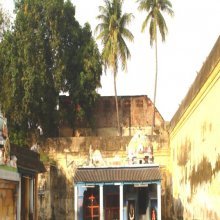Shivalaya, Śivālaya, Shiva-alaya: 12 definitions
Introduction:
Shivalaya means something in Hinduism, Sanskrit, Marathi, Hindi. If you want to know the exact meaning, history, etymology or English translation of this term then check out the descriptions on this page. Add your comment or reference to a book if you want to contribute to this summary article.
The Sanskrit term Śivālaya can be transliterated into English as Sivalaya or Shivalaya, using the IAST transliteration scheme (?).
Alternative spellings of this word include Shivalay.
Images (photo gallery)
In Hinduism
Purana and Itihasa (epic history)
Source: archive.org: Shiva Purana - English Translation1) Śivālaya (शिवालय) is the name of a region situated in the Jñānakailāsa, as defined in the Śivapurāṇa 1.17. Accordingly, “[...] there in the Jñānakailāsa that has five coverings, the primary phallic from of Śiva is stationed in the company of primary energy of Śiva. It has five zones and five Brahmakalās. This is called the abode of Śiva, Śivālaya, the supreme Ātman. There alone stays Parameśvara in the company of Parāśakti. He is skilled in the performance of the five functions of creation, maintenance evanescence and blessing. His body is Existence, Knowledge and Bliss [...]”.
2) Śivālaya (शिवालय) refers to the “temple of Śiva ”, according to the Śivapurāṇa 2.1.13, while explaining the mode of worshipping Śiva:—“[...] after performing the purificatory rite of the Bhūtas [viz., bhūtaśuddhi], the installation of the idol (prāṇapratiṣṭhā) shall be performed. If the worship is performed in the temple of Śiva (śivālaya), the guardians of the quarters (dikpāla) shall be installed and worshipped. [...]”.

The Purana (पुराण, purāṇas) refers to Sanskrit literature preserving ancient India’s vast cultural history, including historical legends, religious ceremonies, various arts and sciences. The eighteen mahapuranas total over 400,000 shlokas (metrical couplets) and date to at least several centuries BCE.
Vastushastra (architecture)
Source: OpenEdition books: Architectural terms contained in Ajitāgama and RauravāgamaŚivālaya (शिवालय) refers to “sanctuary of Śiva §§ 4.2; 5.1.”.—(For paragraphs cf. Les enseignements architecturaux de l'Ajitāgama et du Rauravāgama by Bruno Dagens)

Vastushastra (वास्तुशास्त्र, vāstuśāstra) refers to the ancient Indian science (shastra) of architecture (vastu), dealing with topics such architecture, sculpture, town-building, fort building and various other constructions. Vastu also deals with the philosophy of the architectural relation with the cosmic universe.
Shaivism (Shaiva philosophy)
Source: Brill: Śaivism and the Tantric TraditionsŚivālaya (शिवालय) refers to a “temple of Śiva”, according to the 9th-century Sarvajñānottaratantra chapter 18.—Accordingly, “Next, I shall teach the best observance among observances, which is known as the Śiva-vrata and which is revered by Asuras and Gods alike. [...] Next, I shall teach the characteristics of a temple of Śiva (śivālaya), as well as [how to perform] the installation of the liṅga, in which the universe is [itself] ‘installed.’ All the gods, beginning with Brahmā, reside in the liṅga; therefore a Yogin who venerates his guru, God and the fire and who has performed his vidyāvrata should install the liṅga, following the procedure taught in scripture. [...]”.

Shaiva (शैव, śaiva) or Shaivism (śaivism) represents a tradition of Hinduism worshiping Shiva as the supreme being. Closely related to Shaktism, Shaiva literature includes a range of scriptures, including Tantras, while the root of this tradition may be traced back to the ancient Vedas.
Languages of India and abroad
Marathi-English dictionary
Source: DDSA: The Molesworth Marathi and English Dictionaryśivālaya (शिवालय).—n (S) Any temple dedicated to Shiva. 2 A place where the dead are buried or burned. Such places are sacred to Shiva.
Marathi is an Indo-European language having over 70 million native speakers people in (predominantly) Maharashtra India. Marathi, like many other Indo-Aryan languages, evolved from early forms of Prakrit, which itself is a subset of Sanskrit, one of the most ancient languages of the world.
Sanskrit dictionary
Source: DDSA: The practical Sanskrit-English dictionaryŚivālaya (शिवालय).—
1) Śiva's abode.
2) the red basil. (-yam) 1 a temple of Śiva.
2) a cemetery.
Derivable forms: śivālayaḥ (शिवालयः).
Śivālaya is a Sanskrit compound consisting of the terms śiva and ālaya (आलय).
Source: Cologne Digital Sanskrit Dictionaries: Shabda-Sagara Sanskrit-English DictionaryŚivālaya (शिवालय).—m.
(-yaḥ) Red Tulaśi or basil. n.
(-yaṃ) 1. A cemetery or place where dead bodies are burnt or buried. 2. Any temple dedicated to Siva. E. śiva Siva, and ālaya abode.
Source: Cologne Digital Sanskrit Dictionaries: Cappeller Sanskrit-English DictionaryŚivālaya (शिवालय).—[masculine] Śiva’s abode (a temple or mount Kailāsa).
Source: Cologne Digital Sanskrit Dictionaries: Monier-Williams Sanskrit-English Dictionary1) Śivālaya (शिवालय):—[from śiva] m. ‘Ś°’s abode’, Kailāsa, [Rājataraṅgiṇī]
2) [v.s. ...] ([according to] to some also n.) any temple or shrine dedicated to Ś° (generally containing a Liṅga), [Kathāsaritsāgara]
3) [v.s. ...] a cemetery, place where dead bodies are burnt, [cf. Lexicographers, esp. such as amarasiṃha, halāyudha, hemacandra, etc.]
4) [v.s. ...] Name of a place, [Catalogue(s)]
5) [v.s. ...] red Tulasī or basil, [cf. Lexicographers, esp. such as amarasiṃha, halāyudha, hemacandra, etc.]
Source: Cologne Digital Sanskrit Dictionaries: Yates Sanskrit-English DictionaryŚivālaya (शिवालय):—[śivā+laya] (yaḥ) 1. m. Red tulasi or basil. n. A cemetery; temple of Shiva.
[Sanskrit to German]
Sanskrit, also spelled संस्कृतम् (saṃskṛtam), is an ancient language of India commonly seen as the grandmother of the Indo-European language family (even English!). Closely allied with Prakrit and Pali, Sanskrit is more exhaustive in both grammar and terms and has the most extensive collection of literature in the world, greatly surpassing its sister-languages Greek and Latin.
Hindi dictionary
Source: DDSA: A practical Hindi-English dictionaryŚivālaya (शिवालय) [Also spelled shivalay]:—(nm) a temple of Shiv.
...
Kannada-English dictionary
Source: Alar: Kannada-English corpusŚivālaya (ಶಿವಾಲಯ):—[noun] a Śiva temple.
Kannada is a Dravidian language (as opposed to the Indo-European language family) mainly spoken in the southwestern region of India.
See also (Relevant definitions)
Partial matches: Shiva, Alaya, Civa.
Starts with: Shivalayamahatmya, Shivalayapratishtha, Shivalayapujakrama, Shivalayatantre yantrakrama.
Full-text: Shivalay, Civalayam, Shivalya, Shivalayapratishtha, Sivala, Pitrivanecara, Pancatirtha, Atikarananti, Sivathika, Rampur, Parashakti, Bhaskara, Alaya, Pranapratishtha, Parameshvara, Jnanakailasa.
Relevant text
Search found 10 books and stories containing Shivalaya, Śivālaya, Sivalaya, Shiva-alaya, Śiva-ālaya, Siva-alaya; (plurals include: Shivalayas, Śivālayas, Sivalayas, alayas, ālayas). You can also click to the full overview containing English textual excerpts. Below are direct links for the most relevant articles:
The Shiva Purana (by J. L. Shastri)
Chapter 33 - Origin and glory of the Jyolirliṅga Ghuśmeśvara < [Section 4 - Koṭirudra-Saṃhitā]
Chapter 35 - Śiva-sahasranāma: the thousand names of Śiva < [Section 4 - Koṭirudra-Saṃhitā]
Chapter 1 - The greatness of Jyotirliṅgas and their Upaliṅgas < [Section 4 - Koṭirudra-Saṃhitā]
Rudra-Shiva concept (Study) (by Maumita Bhattacharjee)
14. Twelve Jyotirliṅga incarnations of lord Śiva < [Chapter 5 - Rudra-Śiva in the Purāṇic Literature]
The Skanda Purana (by G. V. Tagare)
Chapter 226 - The Greatness of Vimaleśvara (vimala-īśvara-tīrtha) < [Section 3 - Revā-khaṇḍa]
Chapter 142 - Greatness of the Trio of Gaṇapatis < [Section 1 - Tīrtha-māhātmya]
Chapter 47 - The Genesis of the Name Viśālā < [Section 1 - Avantīkṣetra-māhātmya]
The Linga Purana (by J. L. Shastri)
Chapter 51 - Various Continents < [Section 1 - Uttarabhāga]
Chapter 98 - Thousand names of Śiva (Sahasranāma) < [Section 1 - Uttarabhāga]
Vastu-shastra (1): Canons of Architecture (by D. N. Shukla)
(iv.c) Aparājitapṛcchā (Summary) < [Chapter 5 - Study of Hindu Science of Architecture]
Historical Elements in the Matsya Purana (by Chaitali Kadia)
The Pilgrimages in the Matsya Purāṇa < [Chapter 4 - Geographical history in the Matsya-Purāṇa]




